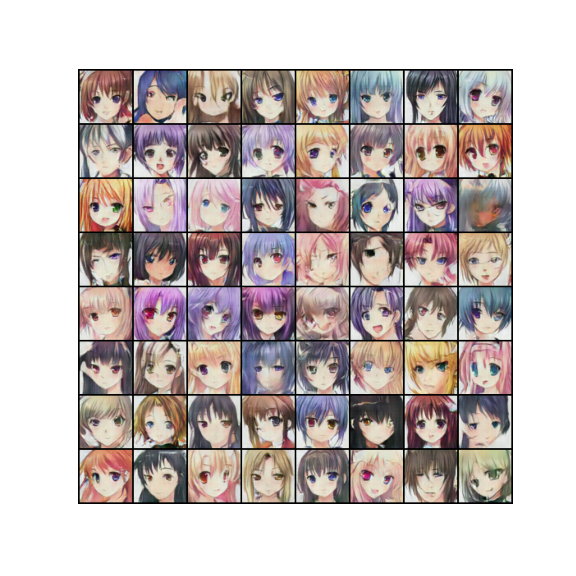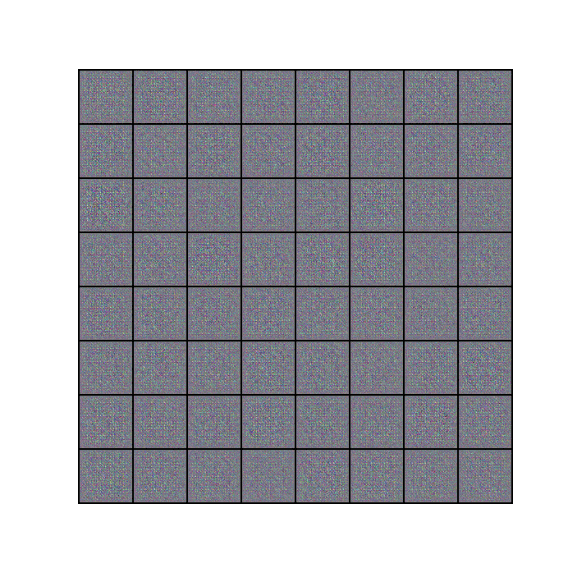GAN(Generative Adversarial Network)とは、本物と見分けがつかないような画像を生成したり、アニメ調の画像へ変換したり、白黒写真をカラーにしたり、画像関連の様々な面白いことができる技術です。2014年にイアン・グッドフェローらにより生み出されました。LeNetを考案したヤン・ルカンには「機械学習において、この10年間で最も面白いアイデア」と称されています。
GANを触ったことがなかったので実装しながら勉強していこうと思います。
GANについて
GANとは何か?仕組みは?など、分かりやすくまとまっているサイトを紹介します。


詳しくは↑サイトを見てください。簡単に説明すると、偽物をつくるGeneratorと、偽物と本物を見分けるDiscriminatorが切磋琢磨するモデルです。
- GeneratorはDiscriminatorを騙せるように学習していく。
- 一方Discriminatorは騙されないように学習していく。
この関係が”敵対的”生成ネットワークということになります。
GANの歴史

GANの研究は近年目覚ましい進化をしており、様々なアルゴリズムが提唱され続けています。代表的なモデルが↑の図になります。今回は「DCGAN」について勉強しようと思います。目標はStyleGANまでやり切りたい。。。
DCGANについて
DCGANはオーソドックスなGANのモデルとなります。GeneratorモデルとDiscriminatorモデルの2つのモデルをつくり連動させていきます。面白いところはGeneratorモデルへ入力するのはノイズ(z)でランダムな数値になります。ノイズをConvTranspose2dでアップサンプリングしていき偽物の画像をつくるんですね。一方でDiscriminatorモデルではConv2dで畳み込みをしていき偽物の画像と本物の画像を見分ける。こんな構造になっています。
図で説明すると↓のようになります。

DCGANを実装していく
PyTorchを使って実装していきます。まず環境設定ですが↓の組み合わせで進めていきます。スナックエンドウの物体検出(YOLOv5)で使った環境設定と同じです。詳細はこちらをご参照ください。
- PyTorch v1.7.1
- NVIDIA CUDA Toolkit 11.1.1
- NVIDIA cuDNN v8.2.0
そして肝心のコードですがPyTorchの公式チュートリアルがあるので、↓のコードに沿って実行していこうと思います。今回実装コードは最後に掲載します。
公式のチュートリアルでは人の顔を学習データとして使っていますが、同じだと面白くないのでkaggleのanime face datasetを使ってやってみようと思います。

データセットををダウンロードし中身を確認してみると、2000年~2019年のアニメフェイス画像があるようで顔がだいぶ違う感じでした。時代を感じますね😎

2000年 アニメ顔

2019年 アニメ顔
2000~2008年と、2009~2019年でデータセットを分割することにしました。
データのディレクトリ構成は↓のようにしてください。
/data_animeface_new
-> img_animeface_new
-> 24433_2009.jpg
-> 24434_2009.jpg
-> 24435_2009.jpg
-> 24436_2009.jpg
...- img_animeface_old : 24,404データ (2000~2008年データ)
- img_animeface_new : 39,161データ (2009~2019年データ)
次に、ハイパーパラメータの調整ですが、PyTorchチュートリアルの↓の部分を書き換えるとOKです。今回はディレクトリの名前と、num_epochsだけ変更しています。epochsを増やすことで良い画像が出力されることが期待されますが、学習時間がかかります。
# Root directory for dataset
# ここでディレクトリを指定
dataroot = "./data_animeface_new"
# Number of workers for dataloader
workers = 2
# Batch size during training
batch_size = 128
# Spatial size of training images. All images will be resized to this
# size using a transformer.
image_size = 64
# Number of channels in the training images. For color images this is 3
nc = 3
# Size of z latent vector (i.e. size of generator input)
nz = 100
# Size of feature maps in generator
ngf = 64
# Size of feature maps in discriminator
ndf = 64
# Number of training epochs
# num_epochs = 5
num_epochs = 100
# Learning rate for optimizers
lr = 0.0002
# Beta1 hyperparam for Adam optimizers
beta1 = 0.5
# Number of GPUs available. Use 0 for CPU mode.
ngpu = 1条件設定はここまでで、あとはチュートリアル通りのコードを実行するだけでOKです。
結果確認
img_animeface_new (2009~2019年データ)を学習したAIがつくり出した画像↓

img_animeface_old (2000~2008年データ)を学習したAIがつくり出した画像↓

崩れている顔もありますが、よく生成できていると思います。また新旧アニメ顔の特徴もよく捉えていますよね🤣
Generatorモデルのトレーニング進捗のアニメーションも可視化できます。最初はノイズですが徐々に顔が生成されるのが分かります。

他にもいろいろやってみたので良かったらこちらもご覧ください↓
実装したPythonコード
from __future__ import print_function
#%matplotlib inline
import argparse
import os
import random
import torch
import torch.nn as nn
import torch.nn.parallel
import torch.backends.cudnn as cudnn
import torch.optim as optim
import torch.utils.data
import torchvision.datasets as dset
import torchvision.transforms as transforms
import torchvision.utils as vutils
import numpy as np
import matplotlib.pyplot as plt
import matplotlib.animation as animation
from IPython.display import HTML
# Set random seed for reproducibility
#manualSeed = 999
manualSeed = random.randint(1, 10000) # use if you want new results
print("Random Seed: ", manualSeed)
random.seed(manualSeed)
torch.manual_seed(manualSeed)
ing=2, normalize=True).cpu(),(1,2,0)))# Root directory for dataset
# ここでディレクトリを指定
dataroot = "./data_animeface_new"
# Number of workers for dataloader
workers = 2
# Batch size during training
batch_size = 128
# Spatial size of training images. All images will be resized to this
# size using a transformer.
image_size = 64
# Number of channels in the training images. For color images this is 3
nc = 3
# Size of z latent vector (i.e. size of generator input)
nz = 100
# Size of feature maps in generator
ngf = 64
# Size of feature maps in discriminator
ndf = 64
# Number of training epochs
# num_epochs = 5
num_epochs = 100
# Learning rate for optimizers
lr = 0.0002
# Beta1 hyperparam for Adam optimizers
beta1 = 0.5
# Number of GPUs available. Use 0 for CPU mode.
ngpu = 1# We can use an image folder dataset the way we have it setup.
# Create the dataset
dataset = dset.ImageFolder(root=dataroot,
transform=transforms.Compose([
transforms.Resize(image_size),
transforms.CenterCrop(image_size),
transforms.ToTensor(),
transforms.Normalize((0.5, 0.5, 0.5), (0.5, 0.5, 0.5)),
]))
# Create the dataloader
dataloader = torch.utils.data.DataLoader(dataset, batch_size=batch_size,
shuffle=True, num_workers=workers)
# Decide which device we want to run on
device = torch.device("cuda:0" if (torch.cuda.is_available() and ngpu > 0) else "cpu")
# Plot some training images
real_batch = next(iter(dataloader))
plt.figure(figsize=(8,8))
plt.axis("off")
plt.title("Training Images")
plt.imshow(np.transpose(vutils.make_grid(real_batch[0].to(device)[:64], padding=2, normalize=True).cpu(),(1,2,0)))# custom weights initialization called on netG and netD
def weights_init(m):
classname = m.__class__.__name__
if classname.find('Conv') != -1:
nn.init.normal_(m.weight.data, 0.0, 0.02)
elif classname.find('BatchNorm') != -1:
nn.init.normal_(m.weight.data, 1.0, 0.02)
nn.init.constant_(m.bias.data, 0)
# Generator Code
class Generator(nn.Module):
def __init__(self, ngpu):
super(Generator, self).__init__()
self.ngpu = ngpu
self.main = nn.Sequential(
# input is Z, going into a convolution
nn.ConvTranspose2d( nz, ngf * 8, 4, 1, 0, bias=False),
nn.BatchNorm2d(ngf * 8),
nn.ReLU(True),
# state size. (ngf*8) x 4 x 4
nn.ConvTranspose2d(ngf * 8, ngf * 4, 4, 2, 1, bias=False),
nn.BatchNorm2d(ngf * 4),
nn.ReLU(True),
# state size. (ngf*4) x 8 x 8
nn.ConvTranspose2d( ngf * 4, ngf * 2, 4, 2, 1, bias=False),
nn.BatchNorm2d(ngf * 2),
nn.ReLU(True),
# state size. (ngf*2) x 16 x 16
nn.ConvTranspose2d( ngf * 2, ngf, 4, 2, 1, bias=False),
nn.BatchNorm2d(ngf),
nn.ReLU(True),
# state size. (ngf) x 32 x 32
nn.ConvTranspose2d( ngf, nc, 4, 2, 1, bias=False),
nn.Tanh()
# state size. (nc) x 64 x 64
)
def forward(self, input):
return self.main(input)
# Create the generator
netG = Generator(ngpu).to(device)
# Handle multi-gpu if desired
if (device.type == 'cuda') and (ngpu > 1):
netG = nn.DataParallel(netG, list(range(ngpu)))
# Apply the weights_init function to randomly initialize all weights
# to mean=0, stdev=0.2.
netG.apply(weights_init)
class Discriminator(nn.Module):
def __init__(self, ngpu):
super(Discriminator, self).__init__()
self.ngpu = ngpu
self.main = nn.Sequential(
# input is (nc) x 64 x 64
nn.Conv2d(nc, ndf, 4, 2, 1, bias=False),
nn.LeakyReLU(0.2, inplace=True),
# state size. (ndf) x 32 x 32
nn.Conv2d(ndf, ndf * 2, 4, 2, 1, bias=False),
nn.BatchNorm2d(ndf * 2),
nn.LeakyReLU(0.2, inplace=True),
# state size. (ndf*2) x 16 x 16
nn.Conv2d(ndf * 2, ndf * 4, 4, 2, 1, bias=False),
nn.BatchNorm2d(ndf * 4),
nn.LeakyReLU(0.2, inplace=True),
# state size. (ndf*4) x 8 x 8
nn.Conv2d(ndf * 4, ndf * 8, 4, 2, 1, bias=False),
nn.BatchNorm2d(ndf * 8),
nn.LeakyReLU(0.2, inplace=True),
# state size. (ndf*8) x 4 x 4
nn.Conv2d(ndf * 8, 1, 4, 1, 0, bias=False),
nn.Sigmoid()
)
def forward(self, input):
return self.main(input)
# Create the Discriminator
netD = Discriminator(ngpu).to(device)
# Handle multi-gpu if desired
if (device.type == 'cuda') and (ngpu > 1):
netD = nn.DataParallel(netD, list(range(ngpu)))
# Apply the weights_init function to randomly initialize all weights
# to mean=0, stdev=0.2.
netD.apply(weights_init)
# Initialize BCELoss function
criterion = nn.BCELoss()
#criterion = nn.HingeEmbeddingLoss(margin=10.0)
# Create batch of latent vectors that we will use to visualize
# the progression of the generator
fixed_noise = torch.randn(64, nz, 1, 1, device=device)
# Establish convention for real and fake labels during training
real_label = 1.
fake_label = 0.
# Setup Adam optimizers for both G and D
optimizerD = optim.Adam(netD.parameters(), lr=lr, betas=(beta1, 0.999))
optimizerG = optim.Adam(netG.parameters(), lr=lr, betas=(beta1, 0.999))
# Training Loop
# Lists to keep track of progress
img_list = []
G_losses = []
D_losses = []
iters = 0
print("Starting Training Loop...")
# For each epoch
for epoch in range(num_epochs):
# For each batch in the dataloader
for i, data in enumerate(dataloader, 0):
############################
# (1) Update D network: maximize log(D(x)) + log(1 - D(G(z)))
###########################
## Train with all-real batch
netD.zero_grad()
# Format batch
real_cpu = data[0].to(device)
b_size = real_cpu.size(0)
label = torch.full((b_size,), real_label, dtype=torch.float, device=device)
# Forward pass real batch through D
output = netD(real_cpu).view(-1)
# Calculate loss on all-real batch
errD_real = criterion(output, label)
# Calculate gradients for D in backward pass
errD_real.backward()
D_x = output.mean().item()
## Train with all-fake batch
# Generate batch of latent vectors
noise = torch.randn(b_size, nz, 1, 1, device=device)
# Generate fake image batch with G
fake = netG(noise)
label.fill_(fake_label)
# Classify all fake batch with D
output = netD(fake.detach()).view(-1)
# Calculate D's loss on the all-fake batch
errD_fake = criterion(output, label)
# Calculate the gradients for this batch, accumulated (summed) with previous gradients
errD_fake.backward()
D_G_z1 = output.mean().item()
# Compute error of D as sum over the fake and the real batches
errD = errD_real + errD_fake
# Update D
optimizerD.step()
############################
# (2) Update G network: maximize log(D(G(z)))
###########################
netG.zero_grad()
label.fill_(real_label) # fake labels are real for generator cost
# Since we just updated D, perform another forward pass of all-fake batch through D
output = netD(fake).view(-1)
# Calculate G's loss based on this output
errG = criterion(output, label)
# Calculate gradients for G
errG.backward()
D_G_z2 = output.mean().item()
# Update G
optimizerG.step()
# Output training stats
if i % 50 == 0:
print('[%d/%d][%d/%d]\tLoss_D: %.4f\tLoss_G: %.4f\tD(x): %.4f\tD(G(z)): %.4f / %.4f'
% (epoch, num_epochs, i, len(dataloader),
errD.item(), errG.item(), D_x, D_G_z1, D_G_z2))
# Save Losses for plotting later
G_losses.append(errG.item())
D_losses.append(errD.item())
# Check how the generator is doing by saving G's output on fixed_noise
if (iters % 500 == 0) or ((epoch == num_epochs-1) and (i == len(dataloader)-1)):
with torch.no_grad():
fake = netG(fixed_noise).detach().cpu()
img_list.append(vutils.make_grid(fake, padding=2, normalize=True))
iters += 1# イタレーションvsロスのグラフ確認
plt.figure(figsize=(10,5))
plt.title("Generator and Discriminator Loss During Training")
plt.plot(G_losses,label="G")
plt.plot(D_losses,label="D")
plt.xlabel("iterations")
plt.ylabel("Loss")
plt.legend()
plt.show()#%%capture
fig = plt.figure(figsize=(8,8))
plt.axis("off")
ims = [[plt.imshow(np.transpose(i,(1,2,0)), animated=True)] for i in img_list]
ani = animation.ArtistAnimation(fig, ims, interval=1000, repeat_delay=1000, blit=True)
HTML(ani.to_jshtml())
#↓コードでアニメーションを保存できます
#ani.save("sample_anime_new.gif", writer="imagemagick")# Grab a batch of real images from the dataloader
real_batch = next(iter(dataloader))
# Plot the real images
plt.figure(figsize=(30,30))
plt.subplot(1,2,1)
plt.axis("off")
plt.title("Real Images")
plt.imshow(np.transpose(vutils.make_grid(real_batch[0].to(device)[:64], padding=5, normalize=True).cpu(),(1,2,0)))
# Plot the fake images from the last epoch
plt.subplot(1,2,2)
plt.axis("off")
plt.title("Fake Images")
plt.imshow(np.transpose(img_list[-1],(1,2,0)))
plt.show()
#↓コードで画像を保存できます
#fig.savefig("img_anime_old.png")


コメント